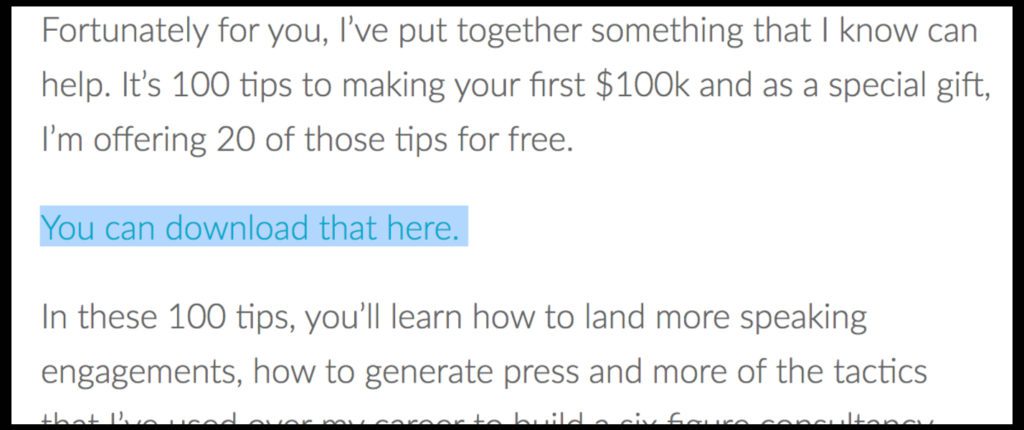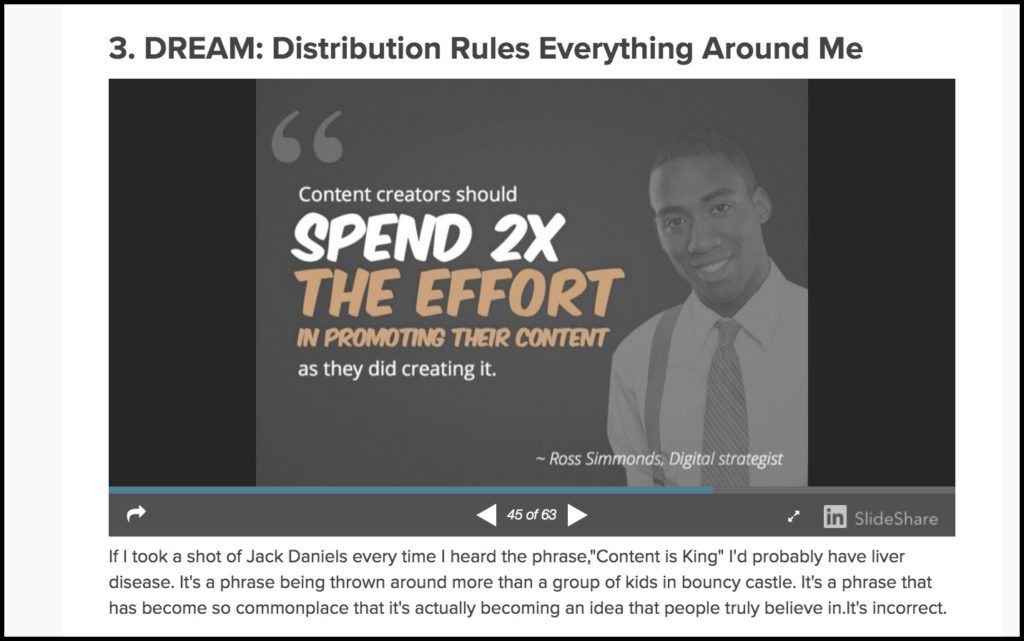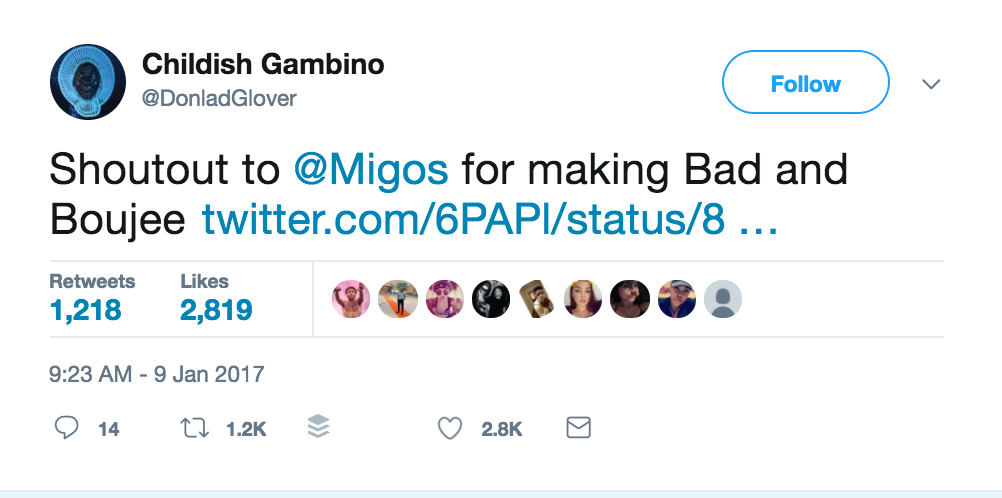When it comes to blogging, it’s close to impossible to know for certain how much traction a single post is going to get. If you run a blog, I’m sure you’ve had posts that you thought would go viral fall flat on their faces instead, and posts that you thought were mediocre generate a wave of traffic you didn’t expect.
If you’re looking for some practical tips and tricks for making your content work consistently, then I’m confident you’re going to enjoy this blog post.
It’s jam-packed with tactical insights on what it takes to create a blog post that resonates and gets shared. I’ve used these marketing tactics with clients and with my own content, and I’ve seen them work wonders. Of course, I can’t promise that these strategies will always deliver viral content, but I can promise that they’ll decrease the chances of your blog post falling flat on its face.
So let’s get to it.
Here are a few actionable blogging tips that will help give your content more life:
Leverage Multiple Content Upgrades
What is a content upgrade?
It can be the difference between a successful blog post and a flop.
Offering upgraded content means creating resources beyond the actual blog post that the reader can download in exchange for giving you their email address. These downloadable resources might be a more in-depth look at a specific topic or a template that would be beneficial to the reader.
Identifying the best type of content upgrade for your audience comes from testing and experiments. What might work well in the world of marketing might not be a great content upgrade if you’re targeting physicians. Here’s an example of a content upgrade from a company that offers landing page software, LeadPages:
In this example, LeadPages offers a three-step process for their content upgrade:
Step 1: Click to show interest in their worksheet.
Step 2: Submit your email to download the worksheet.
Step 3: See a thank-you page and receive an email with the document.
I’ve used this method on my own site and also in guest blog posts:
This content upgrade helped me find new email addresses, adding 250 to my list in one day!
To create a successful content upgrade, first you need to truly understand the mindset and motivations of the person reading your blog post. From there, it’s on you to identify the type of resources this individual would find valuable and worth downloading in exchange for an email. Once you find the email data, make sure to do an SPF record check to ensure your emails are authenticated and secured.
The next time you put together a blog post, think about a downloadable resource that would upgrade your blog post. Sure, it’s going to take a bit of extra time to put this resource together, but a content upgrade could be the key to turning your blog posts into assets that grow your mailing list and generate leads. Plus, with the help of AI, you can use a tool to summarize content and cut down time on content creation.
Remix Old Content Into Your New Post
After creating content for a few months (or even years) you start to build up a reserve of valuable content. Over time, you shouldn’t limit your content output to a single mode; instead, you should diversify the kinds of content you’re putting out there for the world to consume and share.
What do I mean by that?
I mean that you should be creating content assets that aren’t just blog posts. Too many people make the mistake of assuming that blogging is the only type of content that a marketer can create. In reality, the following list represents just a few of the content types that should make up your content marketing mix:
- Quality video content
- Interesting podcast interviews
- Insightful SlideShare presentations
- Unique infographics and diagrams
- Valuable ebooks and guides
Once you’ve built this content, it’s time to start injecting elements of these resources into your blog posts. Let’s say you’ve been running a blog about triathlon nutrition for the last few months, and three weeks ago you created a video about the paleo diet. Now let’s say you’ve decided to create a blog post about Getting In Shape In 2017, and it just so happens that one of your points is all about the paleo diet.
What do you think you should do here?
Create the content from scratch?
Write a bunch of new information about the paleo diet?
Of course not!
You might write a few sentences about it, but in addition, you’re going to embed that video directly into the paleo diet section of your blog post.
Over the last few years, I’ve created lots of SlideShare presentations on topics like Instagram, content creation, Periscope, freelancing and more. In fact, I made an investment worth more than $20,000 in SlideShare presentations. Why?
Because I love the remix.
My many SlideShare presentations can now be used over and over again in my other content. Whether it’s embedding a SlideShare in another blog post like this:
Or putting screenshots of specific slides into my content, the possibilities are endless.
The next time you write a blog post, make it count by including references to other resources throughout. If you have content that can be embedded directly into your blog post, even better! If not, take the time to create link opportunities within your blog post that can drive traffic to your other articles and resources.
Here’s a great video from Britney Muller that talks about the value of remixing content (or refurbishing it):
Capitalize On Every Distribution Channel You Can
It’s so easy to think that your job is done after you press publish on a blog post.
One of the discussions I have with clients over and over again is the importance of distribution. To them, it’s one thing to hire me and my team to create some content; it’s another to invest the time and money into helping that content spread.
This isn’t Field of Dreams.
Even if you build it, they won’t come without more effort on your part.
You need to be willing to invest time and energy into distributing your content across multiple channels. If you haven’t taken the time to identify which distribution channels are likely to work best for you, that’s your homework.
Start by understanding your audience.
What channels are they spending time on? What communities are they using to talk about your industry? What media sites are they following? What Facebook groups are they part of? What Twitter accounts are they retweeting day in and day out? What email newsletters do they subscribe to?
All of these questions need to be answered.
Once you’ve answered them, you can identify distribution tactics that will help you capitalize on these insights about your audience. For example, if you’re targeting venture capitalists, find a list of the most popular venture capital newsletters and figure out a way to get your content in front of the people who curate those newsletters.
Here’s my personal list of distribution hacks:
Click here to get the spreadsheet (FREE) and increase your reach
If you’re struggling to come up with ideas, I’m sure this spreadsheet will help. It covers distribution channels ranging from newsletters and Snapchat to SlideShare and Reddit.
Get Your Team To Show You Love
I’ve noticed something in the last few years that I wish I knew when I was 19:
It’s easier to become successful when you’re committed to helping others be successful.
As much as some people refuse to believe it, the company you keep has an impact on your success. When you make a commitment to helping the people around you achieve their dreams, the people around you tend to help you back.
Call it karma.
Call it a blessing.
Call it whatever you’d like.
The key is finding people who share your mentality and then working together to help both parties achieve success. If you can surround yourself with a group of people (your team) that you can rely on to help distribute your content, you’re less likely to ever produce a blog post that flops.
Some people establish these support teams by creating Facebook groups, Kik chats, GroupMe convos or Slack channels where like-minded people can communicate with one another about their latest and greatest.
For example, you could create a Facebook group and add 6–7 people (after getting their permission) and rely on the group as a place to let each other know when you’ve just released a new post. After you hit publish, you simply share the post in your group, and your team will show you support by sharing it with their audience.
Kinda like this:
I love this tweet from Childish Gambino. In the original clip, he gave a shout out to Migos at the Golden Globes that sent the entire music industry into a fury. Why do I love it?
Because Sunday night, Gambino showed them love, and on Monday they found themselves at the No. 1 spot on the Billboard charts. That’s the power of a team.
Wrapping Things Up
These aren’t the only ways to ensure that your blog isn’t a flop.
There are plenty of other strategies to optimize a blog post for success. From leveraging the headline swapping technique to simply avoiding these content marketing mistakes, the opportunities to improve are endless.
That’s why I love this industry: You can always improve. You can always get better.
And the moment you think you’ve got it all figured out is likely the moment you’ll receive a rude awakening…like a blog post that flops.
What tactics have you seen work well for making every blog post count? Take a moment to share—I’d love to hear from you in the comments!





